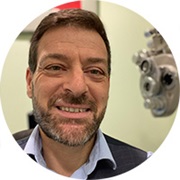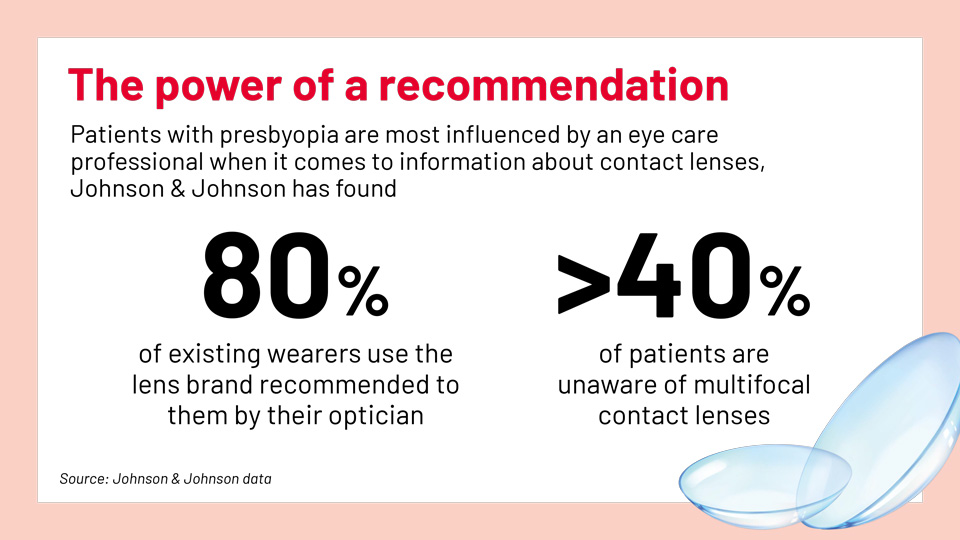- OT
- Industry
- Contact lenses
- Supporting presbyopic patients to achieve contact lens success
In conversation with Johnson & Johnson Vision
Supporting presbyopic patients to achieve contact lens success
Eye care professionals from the Vision team at Johnson & Johnson MedTech share their approach to educating patients on presbyopia, and celebrating the benefits of multifocal contact lenses

02 February 2024

Rachel Hiscox
Occupation: Professional education and development lead

Faye McDearmid
Occupation:Optometrist and professional affairs consultant

James Hall
Occupation:MECS contact lens optician and professional affairs consultant

Robyn Marsden
Occupation:Optometrist and professional affairs consultant
Bridging the chasm of multifocal contact lens wear
Rachel Hiscox, professional education and development lead, Johnson & Johnson, on the opportunities presented by multifocal contact lenses
Despite the growing number of people with presbyopia, there is a ‘presbyopia chasm,’ with the percentage of multifocal lenses fitted in practices remaining low.1 In fact, whilst eight million out of the 15 million presbyopes (aged 45 years and older) in need of vision correction are open to wearing contact lenses, only 3% of these potential wearers are in a multifocal contact lens.2A successful multifocal contact lens fit can provide eye care professionals (ECPs) with an opportunity to see the positive impact they can have on a patient, including quality of life improvements by enhancing day-to-day activities, such as exercise or working on a digital device. Multifocal contact lenses also have the potential to add value for practices, as 89% of contact lens-wearing presbyopes are dual wearers and spend 3.2 times more annually than glasses-only wearers.3
Unfortunately, 62% of those over 45 years old will drop out of wearing contact lenses as they develop presbyopia due to their vision needs no longer being met.3 To help prevent dropout, Johnson & Johnson has focused on innovation across the multifocal segment, aiming to improve the contact lens experience for presbyopes. The latest innovation, ACUVUE® OASYS MAX 1-DAY MULTIFOCAL, providing MAX comfort and MAX clarity* for all day comfort and clear vision, near far and in-between.**⁴ This ensures that the benefits of wearing multifocal contact lenses are maximised for the patient.
ECPs play a vital role in empowering and educating their presbyopic patients about the contact lens options available to them. Johnson & Johnson helps support ECPs in fitting multifocal contact lenses through their extensive professional affairs team and numerous CPD programmes, offered face-to-face and online. The first three episodes of the recently launched Vision Matters podcast by Johnson & Johnson focus on enhancing ECPs’ knowledge and skills to successfully manage presbyopes with a variety of optical solutions and can be easily accessed on Spotify and other platforms.
ECPs play a vital role in empowering and educating their presbyopic patients about the contact lens options available to them

“There is a big grey zone between being comfortable and uncomfortable”
Faye McDearmid, optometrist and professional affairs consultant for Johnson & Johnson, on delving into comfort scores
Contact lenses are important to my practice. Personally, I’ve worn them since I was a teenager, which gives me firsthand experience of the benefits they bring socially, psychologically, cosmetically, and visually, and I want my patients to know they can have that too.
I think we are a typical independent practice in that the majority of our patients are presbyopic. I think there are three types of presbyopes and you need to treat them all differently. There are people who have always had really good vision, and so when they experience presbyopia, it is the first time they have needed vision correction. Then there are people like myself, a long-term contact lens lover, who will get to a stage where it is harder to read with lenses in. Finally, there are people who are happy wearing glasses but find that a varifocal spectacle lens doesn’t suit their lifestyle.
As a patient begins to experience presbyopia, I reassure existing contact lens wearers that they can remain in contact lenses, as they might not be aware of the different options available to them. I have often heard from patients that they used to wear contact lenses but were told they wouldn’t work for them anymore, so stopped.
For those who might require their first vision correction, this is an ideal opportunity to highlight the different solutions and say: “Let’s learn about you, and your visual needs on a day-to-day basis and see what we think is going to fit.” The fun part is matching the patient and their lifestyle with the options available.
When explaining how multifocal lenses work, I explain simultaneous focus by getting them to put their hand up and choose to focus on their fingers or the floor behind them.
I have a lot of patients in my practice who play golf. I ask them: ‘If you were to pick one club, which one would you play the whole round with?' When they say that they would never do that, I explain that it’s the same with vision solutions. You can have one that does everything, but it is probably not going to be perfect for everything. Whereas, if we can look at matching the benefits of each vision solution with a task, then we can get the best of all the technology.
Optometrists and dispensing opticians are familiar with discussing different pairs of spectacles, but are perhaps less acquainted with doing so with contact lenses. This is something teams could work on in training, to make sure everyone is aware of the different options and technologies.
I always use the online fitting calculator. I know it inside and out, but I use it because it is so important that you choose the multifocal lens parameters that the manufacturer intends you to use. I plug the numbers into the calculator in front of the patient and explain: “This is how I am optimising the contact lens prescription for you.” I will explain that this is our starting point, but that I can provide them with more bias for distance or near vision depending on their experience of wearing the lenses.
In an aftercare, if you ask your patient whether everything is ‘okay’ with their contact lenses, they will typically say yes because they are worried to reveal a potential issue that might stop them wearing lenses. I ask my patients to rate how comfortable their contact lenses are out of 10 in the morning, the middle of the day, and the end of the day. Whatever the score is, I ask what would make it a 10? There is a big grey zone between being comfortable and being uncomfortable. We owe it to people to spend time considering: is the lens they are wearing still the one I would fit now, if they were a new client?
Top tips from Faye
- Follow the fitting guide. The more chair time it takes to get the right fit, the more chance you have of the patient losing hope
- Manage patient expectations. I suggest to patients: “If we could get you 80% vision 80% of the time, how would that be? Would you accept a different visual solution for the two out of 10 times where you might need something extra?”
- Get to know the lens designs and material properties available in your practice. This way, you can be confident in providing contact lenses matched to patient needs.
Be proactive
That example made me think: how can we know what we don’t know? We are there to plug that leaky bucket and stop those dropouts from happening. We have got to be proactive about it, because if we’re not, it will keep happening.
“I get my patients to enjoy presbyopia”
James Hall, MECS contact lens optician and professional affairs consultant for Johnson & Johnson, on indicators for presbyopia
Presbyopic patients make up a large proportion of our practice and we know the numbers are growing. For me, the worry is the potential for contact lens drop out as people become presbyopic, because of the perception that they will no longer be able to wear their contact lenses. As a contact lens optician, that is where I love to jump in and say: “No, in fact, you have more options now than you had before.” I see it as an opportunity to create a lifelong relationship with the patient.
More from the JJV experts: read the full series of In Conversation with Johnson & Johnson articles online.
I explain that it’s a normal change. I can empathise and tell them that the same happened to me. Presbyopic patients can feel like they are getting old, which is not a nice thing to go through – especially if you are the first one in your peer group. Nobody wants to be the first one to turn up at the dinner table with a pair of readers. I talk to patients about presbyopia before they have the issue and tell them to give me a call when it happens so I can help them out.
I’m passionate about discussing vision options for different activities and celebrating these with patients. They could have a multifocal contact lens 90% of the time but have a distance pair for when they go to watch football. I tell patients that, just because we fitted one lens, it doesn’t mean there isn’t another option.
I give trial lenses to people who are happy in their contact lenses. As an analogy: I have a smartphone, and I’m pretty happy with it, but if somebody asked if I wanted to trial the latest model for a week or two for free, then I’d probably say yes. So even if somebody has no complaints, I might ask them to try a new lens and give me their feedback on it.
When you fit multifocal contact lenses and it becomes just a part of what you do, you see peoples’ lives transformed by them every day
It’s really important to monitor a patient’s wearing behaviour. It is one of those things that you can’t do unless you are asking the right questions. Before they enter the room, I go back and look at their wearing times over the years. If it used to be 18 hours a day, but has dropped to 12, then 10, then six, and now they are wearing them twice a week and using comfort drops, there is an issue. It is easy to miss unless you look for it.
If a patient asks to cancel their contact lens or solutions subscription because they have a backlog, I will always ask why – because that means they are not wearing the lenses. We need to look out for those little cues.
When you fit multifocal contact lenses and it becomes just a part of what you do, you see people’s lives transformed by them every day. I’ve had people tell me: “You’ve given me my eyes back.” I don’t worry about the odd one that doesn’t like them, because you will get that with glasses, but it doesn’t stop you selling varifocals. I get my patients to enjoy presbyopia instead of enduring it. I approach it as “Oh you’re presbyopic – now look at what we can do.”
Top tips from James
- Pick one of the multifocal contact lenses, get the fitting guide out and learn it until you are an expert. Then do the same for one or two others
- Use the lowest functional add for every patient
- Never guess a best vision sphere. Measure it with your patient. I think it takes a little humility to let your patient tell you: “this is the lens I see best through,” and then it will work, because they have told you.
Life-changing multifocal contact lenses
I saw a patient recently who was really sceptical, and told me when he came in: “I’m only here because my wife told me to come.” After the fitting, he was sitting there for about 30 seconds looking around, just saying: “Oh wow.” He is now telling all of his colleagues that the contact lenses have changed his life and they should all get some. It's such a lovely job.
“Materials really matter in the presbyopic eye”
Robyn Marsden, optometrist and professional affairs consultant for Johnson & Johnson, on physical and visual comfort
Contact lenses give patients the opportunity to have freedom from their glasses. I encourage dual wear with my patients; glasses are great, but it is about being able to give them convenience and letting them know there are choices in how they correct their vision.
As optometrists, we see people who are presbyopic multiple times a day, but for the patient it’s a new concept. One of the barriers to patients wanting to try multifocal contact lenses is that they might know that varifocal glasses require them to move their head, but because they don’t understand how this would work in a contact lens, they might be afraid they won’t be able to do it. The patients who are brave enough to ask will say: “How do I move it so I’m looking through the right bit?” As a profession, I think we’re probably missing a lot of people who just decide to not even ask about contact lenses.
Educating patients is a really key part of our job. Wherever possible, we should preempt presbyopia and let patients know about the great solutions available for once it happens. I think one of the ways to break down the barrier is letting them know that multifocal contact lenses are very different to varifocal glasses, and work in a different way.
Most patients just want a simplified explanation of how they work. I tend to use the raindrop analogy: “Imagine a drop of water on a window. You can choose to look at that if you wish, but if someone comes in and points out the cat in the tree, you will look straight through the window at the cat, and no longer see the glass there. Your brain switches focus.”
I explain that multifocal contact lenses tap into that, working with the brain. This breaks down a lot of barriers, because patients already have that skill, and realise that this is something they can work with.
Making a difference
Materials really matter in the presbyopic eye and can affect both the physical and visual comfort. If your material can integrate well with the patient’s tear film, it makes a difference to how they see because the tear film is the first surface the light rays encounter. If the tear film is as calm as a millpond and not disturbed by the material, you get much crisper vision.
It’s also important to tell patients that, if we go for a particular correction option and it isn’t perfect for them, there are other options available. Make sure they know they can come back to you. Whenever I fit someone with a multifocal, I will follow them up a few days later to ask how it is going, and what their vision and comfort is like. I will reiterate that if it isn’t right, we can try another solution.
Top tips from Robyn
- Get to know your contact lens materials. This is especially important for the presbyopic wearer
- Know your multifocal contact lens designs. Picking the right design can make such a difference to a patient’s real-world vision
- Follow the fit guide. Multifocal contact lenses are innovative and complex, but very easy to fit. Manufacturers have spent years developing their fit guides so you can get the best from the lenses.
Contact lens wear and presbyopia: retention and growth
Johnson & Johnson research indicated an opportunity to introduce more patients with presbyopia to contact lenses and ensure that current contact lens wearers aren’t left behind8 million
people aged 45+ in need of vision correction are open to wearing contact lenses3%
of this group are currently in a multifocal lens89%
of patients with presbyopia are dual wearers3.2x
more spent annually by presbyopes who are dual wearers than those who wear glasses only62%
of those over 45 will drop out of wearing contact lenses as they develop presbyopiaReferences
- Morgan P, Woods C, Tranoudis I, et al. (2022) International Contact Lens Prescribing in 2021. Contact Lens Spectrum 37: 32-38
- JJV Data on file (2022) Growth levers and Internal analysis using Independent 3rd Party Data from the UK
- Data on file, (2022) Incidence UK, CL wearers n=780
- Data on file (2022) Subjective Stand-Alone Claims for ACUVUE® OASYS MAX 1-Day MULTIFOCAL Contact Lenses – Exploratory Meta-analysis
- Aging eyes: A Foundational Exploration. Global Qualitative and Quantitative report. June 2021.
*Versus ACUVUE OASYS 1-Day
**n=378
ACUVUE® Contact Lenses are indicated for vision correction. For detailed product description and safety information, please consult the Instructions for Use or visit our Johnson & Johnson Vision website https://jnjvisionpro.co.uk/instructions-for-use


Comments (0)
You must be logged in to join the discussion. Log in